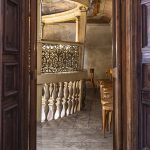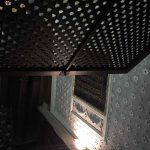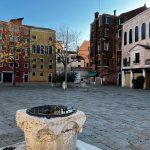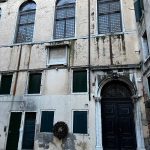HISTORY OF THE JEWISH MUSEUM OF VENICE AND IT’S TREASURES
THE JEWISH MUSEUM OF VENICE
The Jewish Museum of Venice opened immediately after World War II as a mark of confidence in the future of Judaism and of the dignity of mankind. A handful of members of the Venetian Community who had survived the Holocaust got together and pledged to set up Italy’s first Jewish museum. In a building adjacent to the three oldest synagogues in the Ghetto – the German Synagogue, the Canton Synagogue and the Italian Synagogue – the museum comprised two rooms used to house the treasures saved from the barbarity of the Nazis and Fascists, consisting of silver items used in Jewish ritual, ancient fabrics and a few photographs, with no mention of the tragedy so recently experienced.
No one dared to utter the word “Fascism”, and certainly not to sing the praises of Fascism or Nazism. It felt like a chapter of inconceivable atrocities closed for good.
Today the Jewish Museum has grown around those two first rooms and will soon be doubling its surface area thanks to the vast restoration project currently under way. Visitors will be able to inspect the three 16th century synagogues as part of a museum tour in the course of which they can admire fabulous exemplars of Venetian silverware, a fabric collection unparalleled anywhere in the world and an extremely rare collection of books. But the museum will consist primarily of stories of people, of testimonials to the 500-year history of the Jewish minority in the city, of the political compromises they had to enter into with the Most Serene Republic, the bans, the conducts (temporary residence permits), , the cultural activities around which life revolved both inside and outside the Ghetto,, and a great deal more besides.
The museum, whose importance is recognised internationally, will focuse in particular on young people, adopting an innovative approach in which the visitor is the true protagonist of the museum experience.
The heritage preserved by the Jewish Community of Venice is soon to be displayed in a museum that is one of its kind in the world. Thanks a series of fortunate circumstances, the items, most of which are Venetian, come directly from the five synagogues – the German, the Canton, the Italian, the Levantine and the Spanish – and from the three study houses that have remained unaltered since the Ghetto was first established in 1516.
In addition to its artistic value and to the skilled craftsmanship that went into it, the silverware contains inscriptions with names and dedications from donors who were members of the synagogue to which the items were donated. These names today constitute a valuable record that is of crucial importance in fleshing out the historical sources and in reconstructing the histories of families whose surnames can testify to many people’s Jewish descent.
Venetian printing works, frequented by Jews from the outset despite the bans and restrictions put in place, produced what are now extremely rare books which can finally be put on public display.
The art of embroidery and silkworking, a source of income for many Jewish families in the Veneto in the 17th century, will be illustrated in the museum with examples of richly worked brocade, silk, velvet and organza testifying to the highly active and thoroughly organised world of women within the Community.
One of the most important Jewish museums in Italy in terms of the richness and quality of its collections. The ambitious restoration programme currently under way will turn your visit into an unforgettable experience. We shall keep you updated on the progress of the work “ahead of the finishing line!”
HISTORY OF THE JEWISH MUSEUM OF VENICE AND IT’S TREASURES
THE JEWISH MUSEUM OF VENICE
The Jewish Museum of Venice opened immediately after World War II as a mark of confidence in the future of Judaism and of the dignity of mankind. A handful of members of the Venetian Community who had survived the Holocaust got together and pledged to set up Italy’s first Jewish museum. In a building adjacent to the three oldest synagogues in the Ghetto – the German Synagogue, the Canton Synagogue and the Italian Synagogue – the museum comprised two rooms used to house the treasures saved from the barbarity of the Nazis and Fascists, consisting of silver items used in Jewish ritual, ancient fabrics and a few photographs, with no mention of the tragedy so recently experienced.
NO ONE DARED TO UTTER THE WOED “FASCISM”
No one dared to utter the word “Fascism”, and certainly not to sing the praises of Fascism or Nazism. It felt like a chapter of inconceivable atrocities closed for good.
Today the Jewish Museum has grown around those two first rooms and will soon be doubling its surface area thanks to the vast restoration project currently under way. Visitors will be able to inspect the three 16th century synagogues as part of a museum tour in the course of which they can admire fabulous exemplars of Venetian silverware, a fabric collection unparalleled anywhere in the world and an extremely rare collection of books. But the museum will consist primarily of stories of people, of testimonials to the 500-year history of the Jewish minority in the city, of the political compromises they had to enter into with the Most Serene Republic, the bans, the conducts (temporary residence permits), , the cultural activities around which life revolved both inside and outside the Ghetto,, and a great deal more besides.
One of the most important Jewish museums in Italy in terms of the richness and quality of its collections. The ambitious restoration programme currently under way will turn your visit into an unforgettable experience. We shall keep you updated on the progress of the work “ahead of the finishing line!”
The museum, whose importance is recognised internationally, will focuse in particular on young people, adopting an innovative approach in which the visitor is the true protagonist of the museum experience.
The heritage preserved by the Jewish Community of Venice is soon to be displayed in a museum that is one of its kind in the world. Thanks a series of fortunate circumstances, the items, most of which are Venetian, come directly from the five synagogues – the German, the Canton, the Italian, the Levantine and the Spanish – and from the three study houses that have remained unaltered since the Ghetto was first established in 1516.
In addition to its artistic value and to the skilled craftsmanship that went into it, the silverware contains inscriptions with names and dedications from donors who were members of the synagogue to which the items were donated. These names today constitute a valuable record that is of crucial importance in fleshing out the historical sources and in reconstructing the histories of families whose surnames can testify to many people’s Jewish descent.
Venetian printing works, frequented by Jews from the outset despite the bans and restrictions put in place, produced what are now extremely rare books which can finally be put on public display.
The art of embroidery and silkworking, a source of income for many Jewish families in the Veneto in the 17th century, will be illustrated in the museum with examples of richly worked brocade, silk, velvet and organza testifying to the highly active and thoroughly organised world of women within the Community.




























